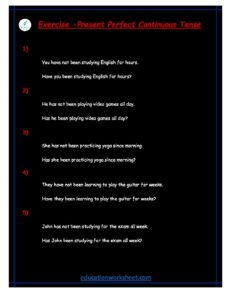Present Tense affirmative examples
Present Tense affirmative examples
The Basic Structure of Present Tense Affirmatives
The structure of a present tense affirmative sentence in English is relatively simple. It typically consists of a subject, a verb, and, in some cases, an object or complement. The verb is usually in its base form (the infinitive form without “to”) for most subjects, with some exceptions for the third person singular (he, she, it), where an ‘s’ is added to the verb. The following are examples of the basic structure in affirmative sentences:
I eat breakfast every morning.
She plays the piano beautifully.
They study hard for their exams.
He likes ice cream.
The sun rises in the east.
Examples of Present Tense Affirmatives

General Present Tense Affirmatives
These statements describe actions or events that happen regularly or are generally true in the present.
I read books for pleasure.
Dogs bark when they’re excited.
We live in a quiet neighborhood.
Habits and Routines
The present tense is often used to talk about habitual actions or daily routines.
She goes for a run every morning.
He watches the news at 6 o’clock.
They drink coffee after dinner.
Facts and Scientific Truths
Present tense affirmatives can be used to state facts and scientific truths.
Water boils at 100 degrees Celsius.
The Earth revolves around the sun.
The human body contains billions of cells.
Opinions and Beliefs
Present tense affirmatives can also express personal opinions and beliefs.
I believe in the power of positivity.
She thinks chocolate ice cream is the best.
They feel that the project is a success.
Descriptive Statements
Present tense affirmatives help in making descriptive statements about something or someone.
The flowers smell wonderful.
His painting captures the essence of nature.
The coffee tastes bitter without sugar.
Narrative Present

The present tense can be used in narratives or storytelling to create a sense of immediacy and engagement.
The sun sets behind the mountains, casting a warm, orange glow.
As she walks into the room, the crowd falls silent.
The detective carefully examines the clues, trying to understand what they mean.
Instructions and Procedures
Present tense affirmatives are used in instructions, recipes, and procedures.
To make a sandwich, first, you take two slices of bread.
When repairing a bicycle tire, you inflate the inner tube to the recommended pressure.
To install the software, you click on the “Install” button.
Scheduled Events
The present tense is used to talk about future events that are part of a fixed schedule or timetable.
The train departs at 7:30 AM tomorrow.
The conference starts next week.
She arrives in two days.
Emphatic Present
Present tense affirmatives can be used to emphasize a current action or situation.
I do believe in second chances.
He does want to meet you.
We do care about the environment.
Simultaneous Actions
Present tense affirmatives can describe actions that are happening simultaneously.
While I read the book, she watches a movie.
They eat dinner and chat at the same time.
He listens to music while he works.
State of Being
Present tense affirmatives are used to describe a state or condition that exists in the present.

The room looks tidy and neat.
She seems happy today.
The city feels alive at night.

